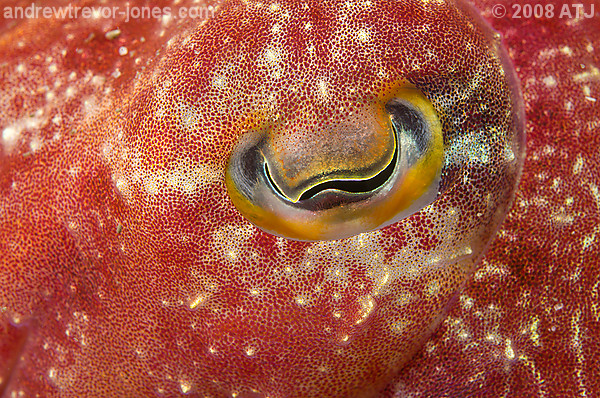
Close up of the head of a reaper cuttlefish, Sepia mestus, showing the coloured spots which are the chromatophores and the white lines are leucophores (at Bare Island).
Original: Thursday 29 August 2013 Update: Wednesday 6 August 2014
I have been fascinated by cephalopods since my mid teens. They are intelligent and their ability to change colour is amazing. I like to see different cephalopods whenever I can. One of my favourite books is A Guide to Squid, Cuttlefish and Octopuses of Australasia by Mark Norman and Amanda Reid. I can spend hours thumbing through it looking at the species I have seen and those I haven't.
The last time I looked through the book I realised that I have pretty much seen all the species listed in the book that could reasonably be found in Sydney. There is probably only one species of coastal cephalopods that are supposedly found in Sydney that I haven't seen and all the others in the book are either open water species or are not found in the Sydney region. I should note that I have also seen many of the tropical species in the book.
It is worth pointing out that Norman and Reid's book only covers described species and there may be many as yet undescribed species in the area and across Australasia according to Mark Norman (pers. com.). Some octopus and small cuttlefish individuals I have seen I have not been sure of their species and they may possibly be as yet undescribed.
Cephalopods are molluscs. Other molluscs are the gastropods (snails and slugs including nudibranchs), bivalves (clams, mussels, oysters, etc.) and chitons. They are characterised by having a ring of arms or tentacles around the head. They have been around for 500 million years.
Cephalopods are highly organised animals with complex behaviour patterns that also have the ability to change their form, mostly in colour but also to a greater or lesser extent their shape, depending on the species. They are mostly soft bodied with little or no skeleton and can also dramatically change their colours making identification potentially troublesome. It is their ability to change colour which makes them fascinating to watch.
Their ability to change colour mostly comes down to their possession of structures in their skin called chromatophores. Each chromatophore is a sac containing pigment controlled by a system of muscle fibres radially inserted to the sac. At rest, the elasticity of the walls of the sac means the sac is contracted, more or less hiding the pigment. When the muscles are contracted they pull the sac open, revealing the pigment inside. The muscle contraction can be precisely controlled so that the size of the sac can vary from 2 to 60 times its contracted size.
Chromatophores cover the skin. They are typically more dense on the upper skin then the lower but they generally cover all the skin and also at least part of the eyes. There may be more than one colour of chromatophore, for example, the reaper cuttlefish, Sepia mestus has three colours: dark brown, red brown and yellow. With different amounts of expansion of each chromatophore, the animal is capable of making a wide variety of different colours using much the same principle as a TV or computer screen. As the chromatophores are under muscular control the colour changes can occur very rapidly.

Close up of the head of a reaper cuttlefish, Sepia mestus, showing the coloured spots which are the chromatophores and the white lines are leucophores (at Bare Island).
In addition to the chromatophores, cephalopods possess iridocytes which unlike the chromatophores are immobile. The iridocytes basically reflect light and come in two types: iridophores which appear blue or green; and leucophores which appear white. The iridocytes are not evenly distributed over the skin surface but usually occur in dense groups as part of the patterning of the animal. For example, the blue lines and rings of a blue-lined octopus are concentrations of iridophores. The iridocytes occur below the layers of chromatophores and so can be dialled up or down by expanding the chromatophores above them.
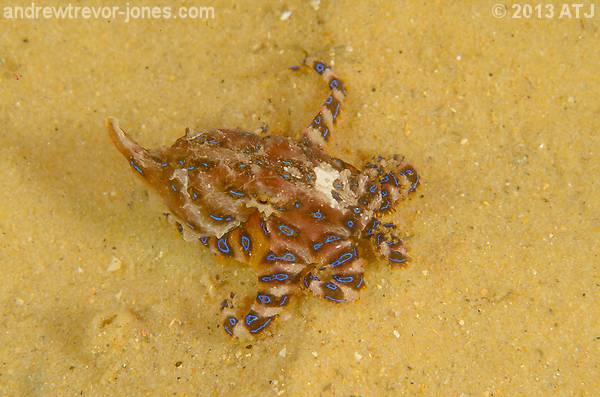
The blue lines and rings of the blue-lined octopus, Hapalochlaena fasciata, are iridophores and can be shown or hidden by changing the chromatophores in the skin layer above (at Camp Cove).
Many cephalopods are able to raise certain areas of their skin and these are called papillae. These can change the general shape of cuttlefish which due to their internal cuttlebone can't vary their basic body shape all that much. The papillae are often used in displays by cuttlefish and octopus.
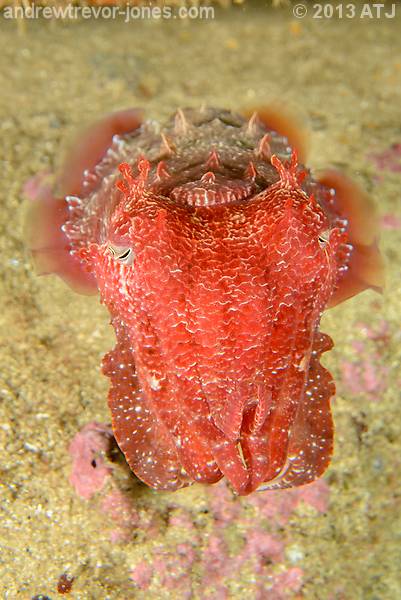
A juvenile giant cuttlefish, Sepia apama, with many papillae raised over its head and body (at Magic Point).
Octopus possess eight arms. Squid and cuttlefish had eight arms and 2 tentacles. The tentacles are much longer than the arms and are used to capture prey. They are not often seen but every now and then you can get lucky and see a feeding cuttlefish with their tentacles extended. When used for capture they can be shot out, catch the prey and bring the prey back to the mouth in less than one third of a second. The arms of all species are used for display as well as manipulating their surroundings.

A hunting mourning cuttlefish, Sepia plangon, with feeding tentacles slightly extended (at Camp Cove).
So, what are the species I've seen and which ones haven't I seen?
I will list the species in the order they appear in Norman and Reid's book.
There are at least 3 species of cuttlefish common to Sydney: giant cuttlefish, Sepia apama; reaper cuttlefish, Sepia mestus; and mourning cuttlefish, Sepia plangon. They are reasonably easy to tell apart, especially mourning cuttlefish, which have a more narrow body shape and tend to have duller colouration. A large giant cuttlefish is unmistakable as reaper cuttlefish never get longer than 20 centimetres, including their arms, and mourning cuttlefish are even smaller. A juvenile giant cuttlefish might get mistaken for a reaper cuttlefish but giant cuttlefish tend to include blue and green in their repertoire of colours whereas the reaper has reds and browns. Giant cuttlefish frequently have more protuberances, especially over the eyes, and have a lot of white lines.
I saw my first giant cuttlefish at Shelly Beach back in the late '70s when I first started diving. I now see them fairly regularly around Sydney. They are relatively common in ocean facing dive sites all around Sydney as well as down the coast to Jervis Bay and beyond. They don't seem to penetrate far into bays, expect for Jervis Bay itself. I have seen juveniles at Camp Cove but at no other locations inside the heads. They are found at Bare Island and Kurnell. The furthest north I remember seeing them is Palm Beach but they are seen in Port Stephens.
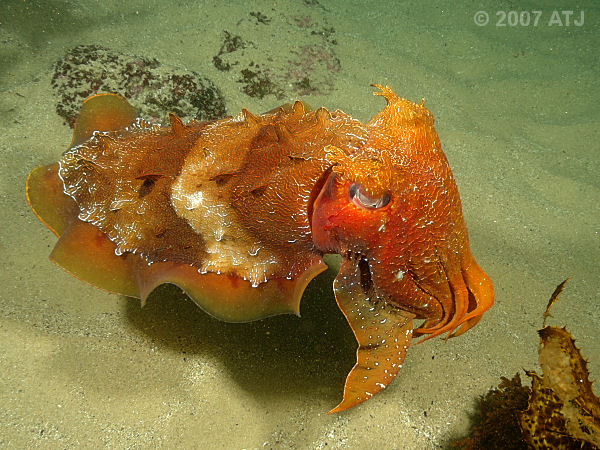
Giant cuttlefish, Sepia apama, at Gordons Bay.
I've had some interesting encounters with giant cuttlefish over the years. I remember watching a pair with eggs at Fairy Bower. One or both individuals appeared to be fanning the eggs, perhaps to keep them oxygenated. On a dive I did at the southern end of Palm Beach in July 1983 we encountered 10-20 giant cuttlefish on the one dive. Each one would display to us with their centre arms raised. While trying to photograph a giant cuttlefish at Kurnell it swam in an embraced me with its arms.
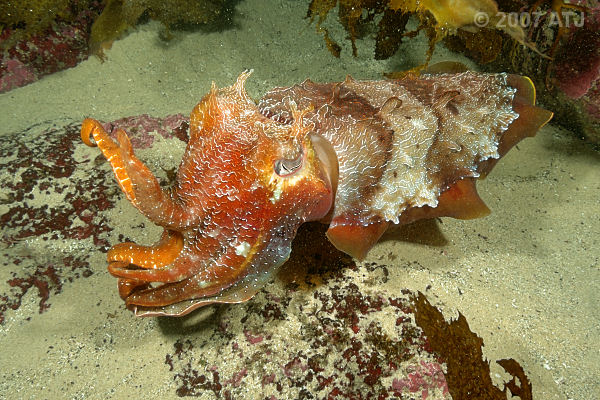
Giant cuttlefish, Sepia apama, at Gordons Bay.
Various giant cuttlefish, Sepia apama, at various locations.
I have a soft spot for reaper cuttlefish. They are the first species of cuttlefish I saw when I started diving and they are also the species I studied for my honours year (although at the time I thought they were Sepia liliana which is an invalid synonym). They appear to be the most common species in Sydney being found in both ocean facing locations as well as well into bays an estuaries. For example, they are common at Shiprock and Clifton Gardens. The are usually seen singularly but occasionally they are seen in pairs. They have great variation in their colours and can go bright red, almost black and almost white as well as a large number of different patterns.
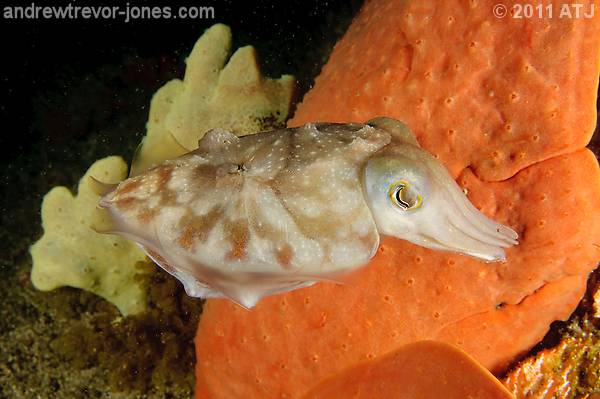
Reaper cuttlefish, Sepia mestus, at Kurnell.
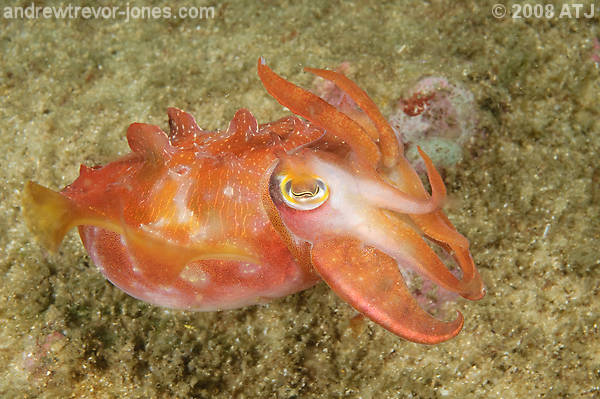
Reaper cuttlefish, Sepia mestus, at Bare Island.
Reaper cuttlefish, Sepia mestus, at The Kurnell.
As the name suggests, this is a tropical species from around Papua, but its distribution extends to temperate western and eastern Australia including to the south coast of New South Wales.
At the time I originally published this blog entry (August 2013), I had not seen what I could be positive was S. papuensis. I wasn't even sure how to tell them apart from S. plangon which look similar in Norman and Reid's book. In May 2014, I did a night dive at Seahorse Gardens, Nelson Bay with Dave Harasti. Before the dive Dave told me that we might see S. papuensis on the dive and they could be recognised as being quite large and the way they rest in a depression in the sand. Sure enough on the dive I saw at least 3 and they were easy to recognise. I now know I had not seen this species before and know that I will recognise them if I see them again, especially by the behaviour of resting in a depression. The patterning on their mantle is quite distinguishing, too.

Papuan cuttlefish, Sepia papuensis, at Nelson Bay, resting in a depression in the sand.
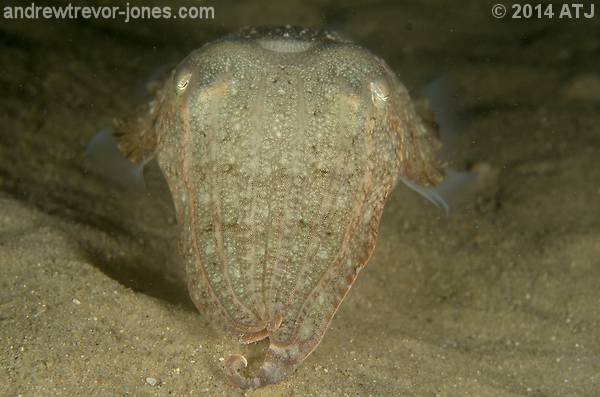
Papuan cuttlefish, Sepia papuensis, at Nelson Bay, after floating up from its resting place.
I saw my first mourning cuttlefish in the late '70s while diving near Spit Bridge. There was a pair and they were displaying to me with their central arms raised. This appears to be the classic pose of mourning cuttlefish and most seem to do it during an encounter with them. Interestingly, the majority of mourning cuttlefish I have seen have been in pairs. Almost all I have seen have been in sheltered bays and estuaries. They are common in Sydney Harbour at Camp Cove and Clifton Gardens as well as being common at Shiprock. I have seen them at Kurnell bit only after heading around the corner into Botany Bay proper.

Mourning cuttlefish, Sepia plangon, at Shiprock.
They tend not to be as colourful as giant and reaper cuttlefish but they are still quite capable of putting on an impressive display, especially while courting.

Mourning cuttlefish, Sepia plangon, at Shiprock.
A male and female mourning cuttlefish, Sepia plangon, displaying, with a third interloper, probably another male (at Fly Point, Port Stephens).
There are only three species in this family in Norman and Reid's book, two of which are found in Sydney. The World Register of Marine Species lists a total of 9 species. All species are reported to bury themselves in sand during the day and come out at night to hunt for prey. They all produce mucus from the underside of their body when disturbed.
Interestingly, bottletail squid are taxonomically more closely related to cuttlefish than to bobtail squid even though the resemble the latter more than the former.
The southern bottletail squid is a very new cephalopod for me. I only saw my first one on a night dive at Camp Cove in January 2013. They are an interesting little squid looking similar to a dumpling squid but with the capability of going bright orange. In fact, the first one I saw I thought was a southern dumpling squid until I looked more closely at the photographs. They also behave much like dumpling squid and pyjama squid in the way they bury themselves in the sand. Each time I have encountered them they have been partially buried in the sand with only their eyes and part of their back exposed.
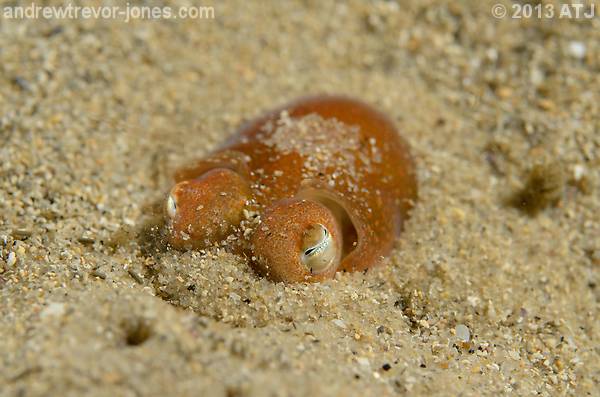
Southern bottletail squid, Sepiadarium austrinum, partially buried in the sand at Clifton Gardens.
Southern bottletail squid can vary their colour from bright orange to nearly transparent with large white iridescent spots called leucophores. I watched one that was bright orange shoot off after I took its photo. It shot a load of ink and then changed to almost transparent as it rapidly swam off. I could see how easily this could confuse prey.
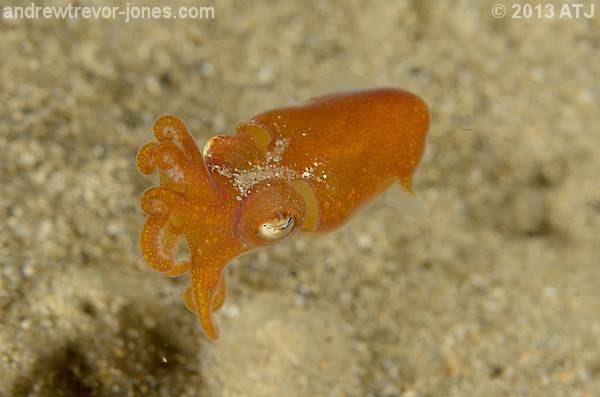
Southern bottletail squid, Sepiadarium austrinum, swimming with orange colouration (at Clifton Gardens).
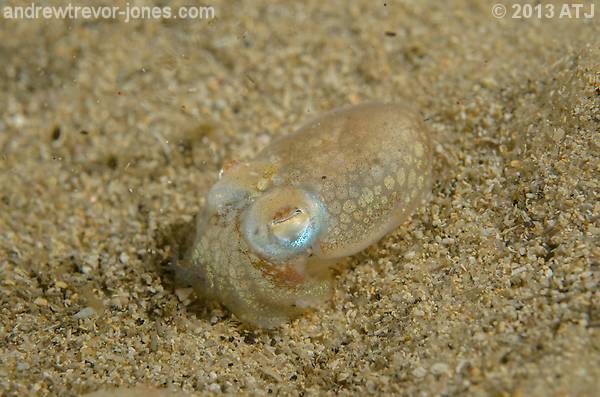
Southern bottletail squid, Sepiadarium austrinum, resting and almost clear showing leucophores (at Clifton Gardens).
The striped pyjama squid is also a type of bottletail squid. They have a similar shape to the southern bottletail squid although are perhaps a little more squat. They also grow to almost twice the size of the southern bottletail squid. They are white with dark brown stripes although they can fade the stripes to almost nothing.
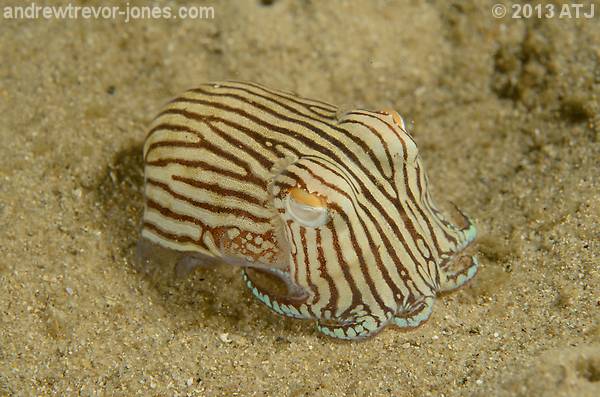
Striped pyjama squid, Sepioloidea lineolata, showing the dark stripes on white body (at Clifton Gardens).

Striped pyjama squid, Sepioloidea lineolata, with very pale stripes (at Camp Cove).
Like the southern bottletail squid, the striped pyjama squid is often found partially buried in the sand with only its eyes and perhaps part of its mantle exposed.
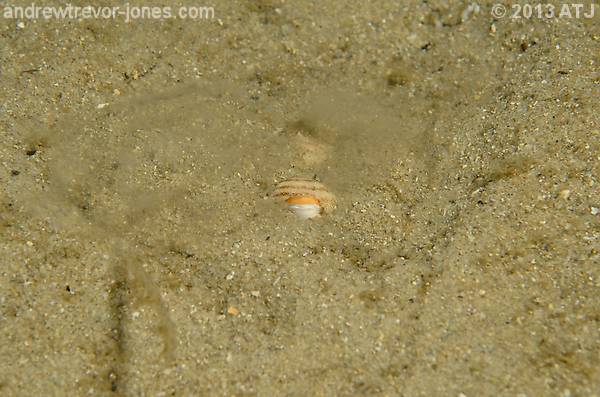
Striped pyjama squid, Sepioloidea lineolata, buried in the sand with only its eyes exposed (at Clifton Gardens).
I saw my first striped pyjama squid in the wild in April 2012 on a night dive at Shiprock. I now see them regularly on night dives as both Camp Cove and Clifton Gardens.
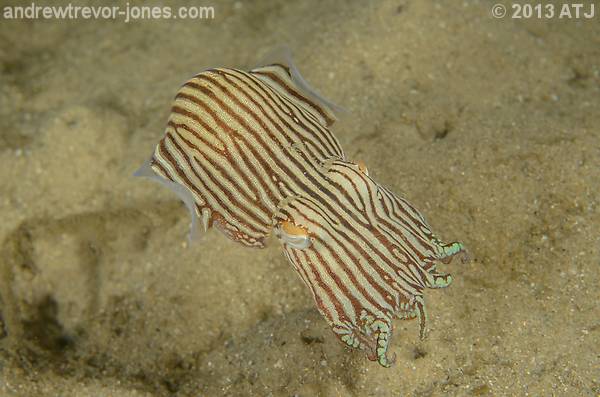
A swimming striped pyjama squid, Sepioloidea lineolata, (at Clifton Gardens).
The World Register of Marine Species lists 101 species in this family. Norman and Reid list 2 species in Australasia with one from Sydney.
Southern dumpling squid are a similar shape and size to the striped pyjama squid even though they belong to a different family. They have an iridescent layer of skin below a layer of skin that has brown chromatophores giving them a brown spotted pattern. Like other cephalopods they can vary the size of the chromatophores to change their colouration. Like the bottletail squid, southern dumpling squid are often found partially buried in the sand with only their eyes and part of their mantle exposed. At night they swim around looking for prey.

Southern dumpling squid, Euprymna tasmanica, at Camp Cove.
I first saw southern dumpling squid on night dives in Smiths Lake (near Forster) while on field trips for university. They were quite common on the bottom of the lake. I didn't see one in Sydney until a night dive at Camp Cove in December 2012. I have since seen quite a few on night dives at Camp Cove and Clifton Gardens.
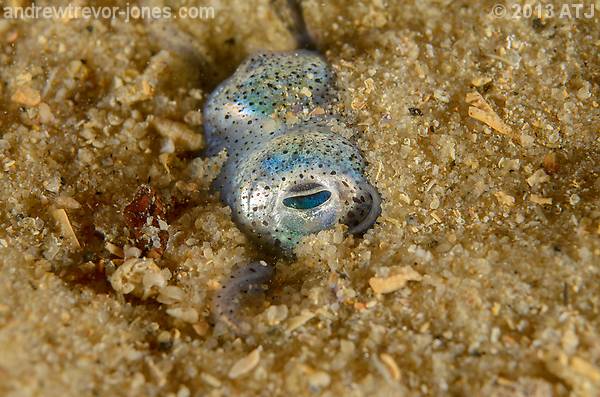
Partially buried southern dumpling squid, Euprymna tasmanica, at Camp Cove.
Norman and Reid list 2 species of loliginids in the Sydney region, however, I'm not sure I can accurately distinguish between them, especially for small individuals. The luminous bay squid only grows to 8 centimetres so anything larger than that should be a southern calamari squid (assuming they really are the only two similarly looking squid in the area). If the squid is 8 centimetres or less, in theory it could be either species. Luminous bay squid have triangular fins on the posterior of the mantle whereas southern calamari squid has fins extending the whole length of the mantle. The problem is that it is not always easy to get a good view of the fins. Luminous bay squid have a pair of light organs inside the mantle cavity and when these are visible, identification is much easier.
I believe I see the luminous bay squid frequently on night dives but due to the problems mentioned above with identification, I'm not always certain I'm seeing the luminous bay squid rather than the southern calamari squid. Those I have seen tend to be in small groups of two or more individuals and tend to be attracted by the dive lights. They don't always swim away and it is sometimes possible to take their photograph.

Luminous bay squid, Loliolus noctiluca, at Long Bay.
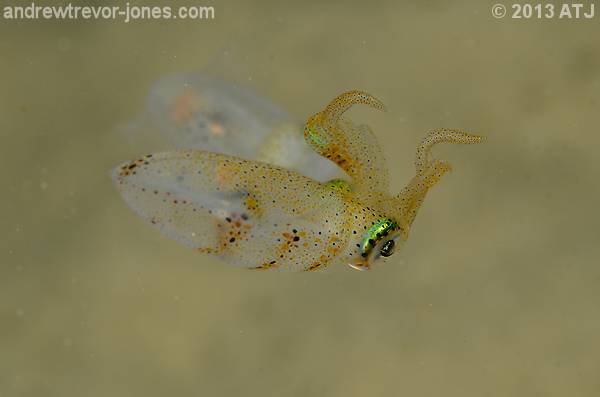
Luminous bay squid, Loliolus noctiluca, at Clifton Gardens. The light organs can just be seen inside the mantle cavity.
I have been seeing southern calamari squid since the time I started diving. Even when I was snorkelling at Shelly Beach, I would regularly see small schools of these squid in the shallows. I know they were southern calamari squid due to their size. We often see them at Kurnell anywhere from The Monument to The Leap usually close to the sand line but also over the reef, 3 to 5 metres off the bottom. They do get quite large, up to 30 centimetres in length. We often see them on night dives and they attracted to the dive lights much like the luminous bay squid.
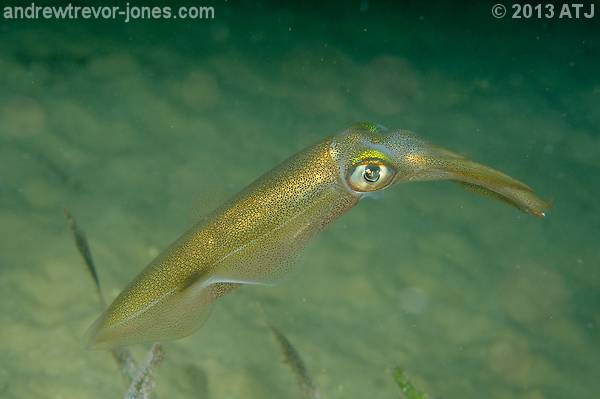
Southern calamari squid, Sepioteuthis australis, at Camp Cove.
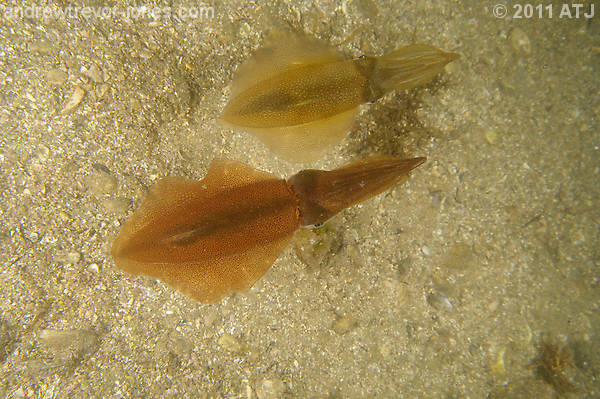
Southern calamari squid, Sepioteuthis australis, at Bare Island.
The family of benthic (bottom dwelling) octopus is very large with hundreds of described species. Norman and Reid list only 3 species from the Sydney region but there may well be more. I often see octopus that I can't be sure are one of the listed species.
The blue-lined octopus is a species of blue-ringed octopus and like the other species posses a strong toxin used to paralyse its prey. The blue-lined octopus is known to have caused at least one human death in Sydney. The toxin, tetrodotoxin, is the same as that found in pufferfish (e.g. fugu) and a number of other organisms, including toads. In blue-ringed octopus is it produced by bacteria in the salivary glands. Even newly hatched blue-ringed and blue-lined octopus have been found to be venomous. The toxin causes paralysis and eventually death due to respiratory failure and/or cardiovascular collapse. According to Mark Norman (pers. comm.) the octopus can choose not to delivery any toxin when it bites so a bite is not necessary fatal. Regardless, they should not be handled.

Blue-lined octopus, Hapalochlaena fasciata, at Camp Cove.
The blue-lined octopus gets its common name from the fact that it has more blue lines than the blue rings present on the other species from the tropics and around Victoria and Tasmania.
I saw a few blue-line octopus in my early days of diving at Long Reef and Shelly Beach. These sightings occurred during the day. I was not to see another one until a night dive at Camp Cove in December 2012. I now see them semi-regularly on night dives at Camp Cove and Clifton Gardens. The blue lines were visible in almost all undisturbed individuals. I think I have seen only one where the blue lines were not showing.
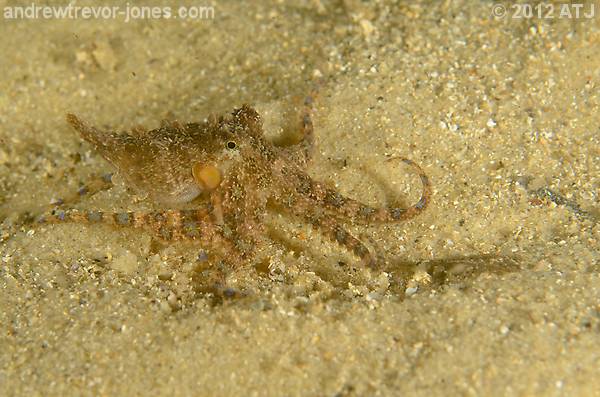
Blue-lined octopus, Hapalochlaena fasciata, with blue lines and rings more subdued (at Camp Cove).
On night dives the octopus have been seen wandering about on the sand or in one case on the netting at Clifton Gardens.

Blue-lined octopus, Hapalochlaena fasciata, on the netting around the pool at Clifton Gardens.
Hammer octopus get their name from the club-like modified arm tip found in mature males which is used to pass sperm to the female. They are a sandy cream in colour and have a keel like ridge on the side of the mantle. All the ones I have seen have had two white patches just in front of the eyes.
I have only seen these octopus on night dives at Camp Cove.
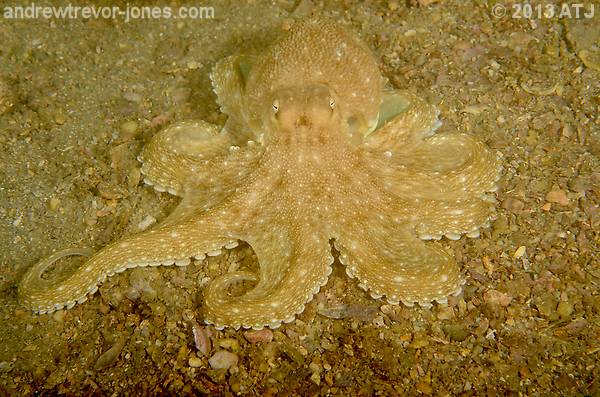
Hammer octopus, Octopus australis, at Camp Cove.
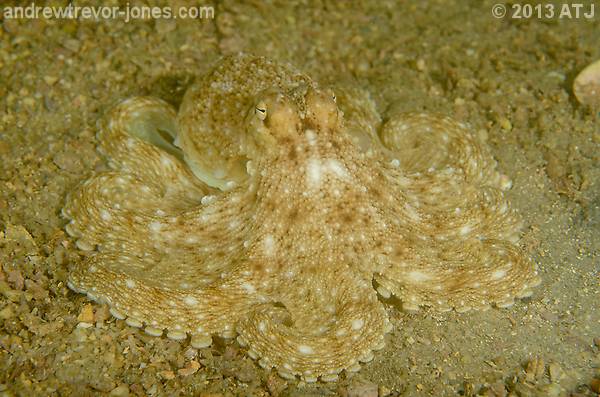
Hammer octopus, Octopus australis, at Camp Cove.
The common name for this octopus is very accurate. They are very common all around Sydney. I can't think of a dive site I haven't seen them. While they usually aren't out and about during the day, they are still frequently seen partially exposed under rocks and in crevices. At night they are often seen wandering about.
They can easily be identified by the eye that is mostly white and the underside of the arms which are mostly orange.

Common Sydney octopus, Octopus tetricus, at Camp Cove.
I have seen the common Sydney octopus since I started diving and it is rare I don't see one on a dive.

Common Sydney octopus, Octopus tetricus, at Clifton Gardens.
According to Norman and Reid, there are at least one other species of cephalopod in Sydney and I do not believe I have seen this species.
The southern pygmy squid is tiny, less than 2 centimetres in length and so could easily be overlooked. They live in seagrass beds and during the day they attach themselves to the undersurface of the seagrass blades using a special adhesive gland on the rear upper surface of the body. It releases itself at night and swims around the seagrass beds hunting for shrimp to eat.
I really need to search for these guys as I'm sure I should be able to find them.